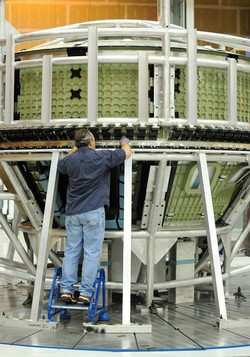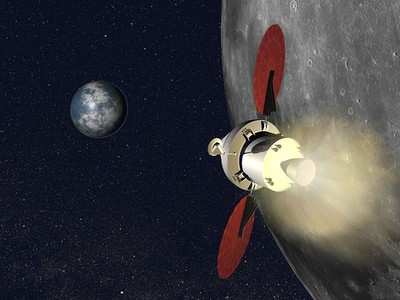Wed, Jun 16, 2010
Prime Contractor Lockheed Martin Fuses The Two Halves Of The
Crew Module
The Orion crew exploration vehicle took shape as the two halves
of the crew module were fused together at NASA's Michoud Assembly
Facility in New Orleans, LA Tuesday. The Lockheed Martin Orion team
welded the forward cone assembly to the aft barrel assembly using
the next generation friction stir weld process. The 445-inch long
weld is the longest such weld of its kind and will ensure optimal
structural integrity for the harsh environments of space
flight.

Orion Crew Module Takes Shape
The completion of the crew module welds marked another key
milestone for the Orion crew exploration vehicle, completing the
structural framework of the spacecraft. All welds have met
stringent quality requirements without any rework required. Prior
to flight testing, this crew module will be tested on the ground in
flight-like environments, including static vibration, acoustic, and
water landing tests. Results will be used to correlate sizing
models for all subsystems on the vehicle.
Orion weld operations take place on a Universal Weld System II
(UWS II) that includes a 22-foot diameter turntable, a
self-reacting friction stir weld head and a modular t-grid floor.
The system affords virtually unlimited five-axis welding on
fixture-mounted hardware. The UWS II is part of the National Center
for Advanced Manufacturing, managed by the University of New
Orleans Foundation in partnership with NASA and the State of
Louisiana.

Artist's Rendering Orion Returning From The
Moon
The friction stir welding process advances the state-of-the-art
for circumferential welds, yielding higher strength and higher
quality welds at a lower cost. The latest state-of-the-art
manufacturing technologies, efficient processes and new materials,
such as the ultra-light weight Aluminum-Lithium alloy, are all
being employed on Orion to produce the lightest possible vehicle
for space flight.
"The combination of material and manufacturing advancements in
technology are key reasons why the spacecraft is more lightweight
and damage resistant than many industry experts thought possible,"
said Larry Price, Lockheed Martin Orion deputy program manager.
"The balance of manufacturing methods and varied materials such as
composites and advanced alloys that have been applied to Orion
resulted in vehicle optimizations across the board - lowest cost,
lightest weight, and improved structural integrity, which is
critical to crew safety."
More News
Mid-Continent Instruments and Avionics and True Blue Power ANN's NBAA 2025 Coverage... Visit Them At Booth #3436 True Blue Power Introduces New 45-watt Charging Ports for 14- and 2>[...]
En Route Automation System (EAS) The complex integrated environment consisting of situation display systems, surveillance systems and flight data processing, remote devices, decisi>[...]
“Our Kodiak aircraft family is uniquely designed to meet the rigorous demands of such deployments, bringing short takeoff and landing performance, robust cargo capacity and e>[...]
Aero Linx: Australian Society of Air Safety Investigators (ASASI) The Australian Society of Air Safety Investigators (ASASI) was formed in 1978 after an inaugural meeting held in M>[...]
Left Main Landing Gear Struck A Bush, And The Right Wingtip Impacted The Ground Analysis: According to the pilot of the tailwheel-equipped airplane, he noticed that the engine oil >[...]
 True Blue Power and Mid-Continent Instruments and Avionics Power NBAA25 Coverage
True Blue Power and Mid-Continent Instruments and Avionics Power NBAA25 Coverage ANN's Daily Aero-Term (10.15.25): En Route Automation System (EAS)
ANN's Daily Aero-Term (10.15.25): En Route Automation System (EAS) Aero-News: Quote of the Day (10.15.25)
Aero-News: Quote of the Day (10.15.25) ANN's Daily Aero-Linx (10.15.25)
ANN's Daily Aero-Linx (10.15.25) NTSB Final Report: Jeremy S Lezin Just SuperSTOL
NTSB Final Report: Jeremy S Lezin Just SuperSTOL




